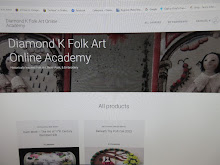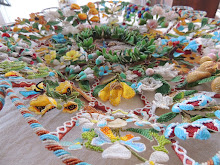
Silhouette wise, the 1830s are my favorite era, just imagine a whole schoolroom full of sweet little cherubs...and some not so sweet I'm sure, bobbing about and playing in dresses such as this, but in a more washable cotton vis silk.

This dress was in my mind when I designed Tascha's dress, but since Tascha is older, and not a child, I gave her a wider and fuller pleated band on the front of her gown, more grown up. Here you can see the pleating on the sleeves to hold the fullness in, and the superb use of the stripe to lend effect of movement
 Doesn't Emma look like she could have walked into a store, and picked out a new dollye to take home? She is holding a c1820 patchwork reticule in silks, and wearing a period net cap
Doesn't Emma look like she could have walked into a store, and picked out a new dollye to take home? She is holding a c1820 patchwork reticule in silks, and wearing a period net cap I could see a smile stretch on Tascha's face, a feeling of being one and whole again. At one time, a little girl beheld her for the first time, just like this
I could see a smile stretch on Tascha's face, a feeling of being one and whole again. At one time, a little girl beheld her for the first time, just like this I hand stitched her dress(Tascha) from mid 19th c very thin calico. I did NOT wash it, as the age marks do nothing but add character and realism~ she loves her new dress. The arm, shoulder and side seams are piped, as well as the front plastron that holds the pleats down.
I hand stitched her dress(Tascha) from mid 19th c very thin calico. I did NOT wash it, as the age marks do nothing but add character and realism~ she loves her new dress. The arm, shoulder and side seams are piped, as well as the front plastron that holds the pleats down. There are 2 piped bands round each sleeve, and I faced about the bottom 5" of her skirting with heavy polished cotton, as it just didn't hang right without the added weight. She wears her new dress over polished cotton petticoat, corset, chemise and pantaloon, all hand stitched from antique fabrics.
There are 2 piped bands round each sleeve, and I faced about the bottom 5" of her skirting with heavy polished cotton, as it just didn't hang right without the added weight. She wears her new dress over polished cotton petticoat, corset, chemise and pantaloon, all hand stitched from antique fabrics. I will be posting her dressing into her corset in the next few days. Dollys like this were used for play, but also to teach the little ones proper dress, and what work was required in getting in and out of everything. Imagine if all they had to do was learn how to tie their shoes....instead of lace up a corset for their sister!
I will be posting her dressing into her corset in the next few days. Dollys like this were used for play, but also to teach the little ones proper dress, and what work was required in getting in and out of everything. Imagine if all they had to do was learn how to tie their shoes....instead of lace up a corset for their sister! Dancing and Dreaming with dollye...........how I would love to spend all of my days
Dancing and Dreaming with dollye...........how I would love to spend all of my days




 Speaking of the eyes.... both hammered and not hammered are common, and not really a good way to tell the date of a garment(assuming they are original to it) This is the most common shape however, and if you see some weird fancy scrolling or
Speaking of the eyes.... both hammered and not hammered are common, and not really a good way to tell the date of a garment(assuming they are original to it) This is the most common shape however, and if you see some weird fancy scrolling or 

 On this 1840 dress, you can see plainly that the hook is made from a single piece of wire
On this 1840 dress, you can see plainly that the hook is made from a single piece of wire This picture shows a brass fastening set c1890. Note the triangular shape of the eyes, and the '
This picture shows a brass fastening set c1890. Note the triangular shape of the eyes, and the '
 This picture shows, tho a little blurry, the different between an early and modern one~ the hook on
This picture shows, tho a little blurry, the different between an early and modern one~ the hook on  That 3rd wire, (the modern ones are still just made from a single wire, they are just wrapped differently) is what makes the 'safety catch' on the back of the hook. Some of them have such a high bump, that they really are quite difficult to get unhooked, and when hooked into the eye, or loop, make a little 'snap' noise. You can see the early hook has an entirely FLAT back.
That 3rd wire, (the modern ones are still just made from a single wire, they are just wrapped differently) is what makes the 'safety catch' on the back of the hook. Some of them have such a high bump, that they really are quite difficult to get unhooked, and when hooked into the eye, or loop, make a little 'snap' noise. You can see the early hook has an entirely FLAT back.





























